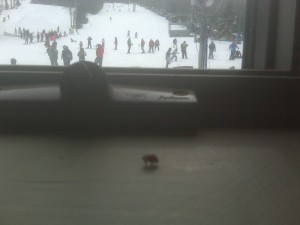A few weeks ago, I snapped a photo of my kids skiing in the Poconos (while I hung out in the lodge). I noticed this ladybug walking along the windowsill. A quick Google search informed me that it’s not uncommon for folks living in mountainous regions to be invested with ladybugs seeking shelter in the winter. Sure enough, after spotting this one, I found dozens more. What’s not known is why some unlikely places are becoming infested while others are witnessing a collapse of ladybug populations.
Citizen scientists: the Lost Ladybug Project needs your help to solve this mystery!
Across North America ladybug species distribution is changing. Over the past twenty years several native ladybugs that were once very common have become extremely rare. During this same time ladybugs from other places have greatly increased both their numbers and range. Some ladybugs are simply found in new places. This is happening very quickly and we don’t know how, or why, or what impact it will have on ladybug diversity or the role that ladybugs play in keeping plant-feeding insect populations low. We’re asking you to join us in finding out where all the ladybugs have gone so we can try to prevent more native species from becoming so rare.
Find out how you can get involved. You’ll even learn how to relax a ladybug for the purpose of taking its picture. (Hint: a ladybug can be placed in a freezer for up to five minutes. True fact!) Consider sharing your experience on your very own Member Blog here on ScienceForCitizens.net (free benefit for subscribers!).


